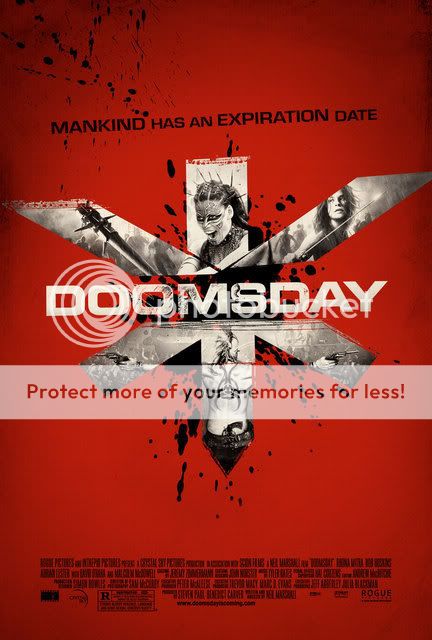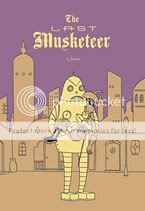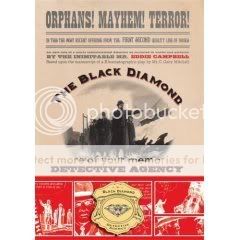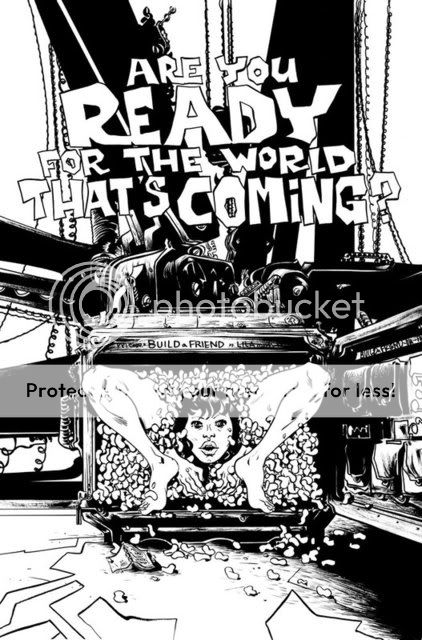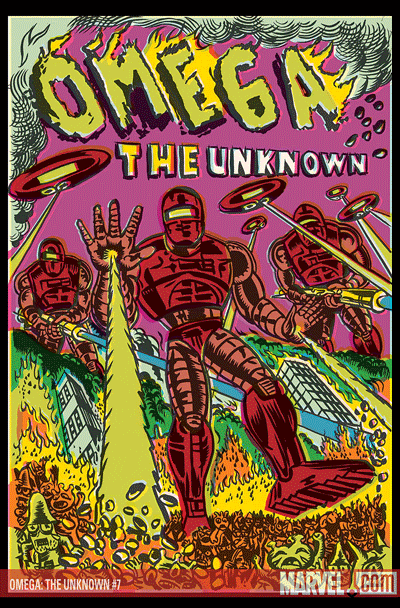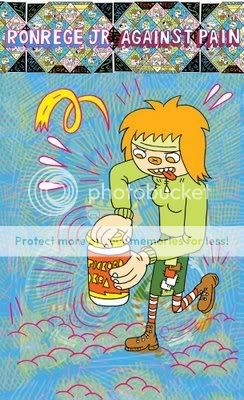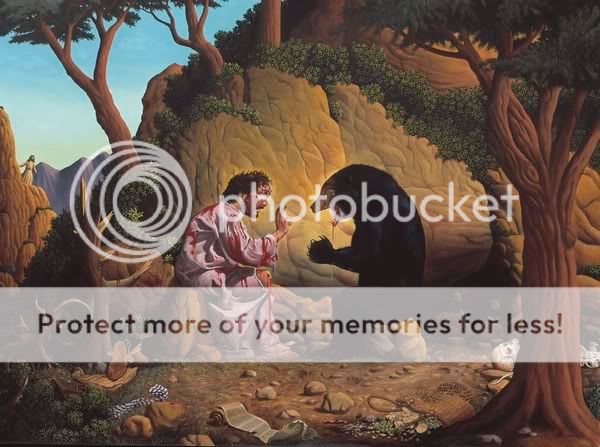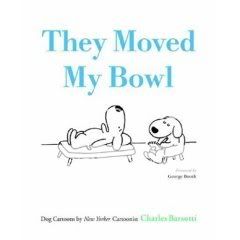Archive for January 31, 2008
Carnival of souls
January 31, 2008* With Lost Season Four mere minutes away, the L.A. Times’ Patrick Day lists 48 (mostly) unanswered questions from the preceding three seasons. (Via Whitney Matheson.)
* Meanwhile Topless Robot’s Rob Bricken and John Frusciante (no relation, as far as I know) list the show’s 24 biggest assholes—so, y’know, it’s a list of all the characters.
* At the New York Times’ Paper Cuts book blog, Saturday Night Live’s Bill Hader recommends several sci-fi and horror books, including Day of the Triffids and (now you’ll see why I’m linking this) Clive Barker’s Books of Blood (Via Whitney Matheson again.) Sample quote:
A friend of mine, years ago, gave me this, and I read the first two stories and was like, “I can’t handle this.” Then I read an interview with Alan Moore, and he was talking about how “Books of Blood” is one of the greatest collections of short stories ever. So I took another look, and it was so hilarious.
* Neil Marshall has posted the new one-sheet for his upcoming post-apocalypse action flick Doomsday. As with the trailer, I’m not sure I’m feeling it. I like that more thought was put into the design than just a blue-tinted giant face, but I feel like people might look at this and think it’s about Earth being invaded by female Darth Mauls and BloodRayne.
* Finally, a big thumbs-up to Jason Adams for joining me in making the connection between the key line of dialogue in No Country for Old Men and the chorus of the Tori Amos song “Bells for Her.”
Carnival of souls
January 30, 2008* Clive Barker talks to Chicago Tonight for a lengthy look at a show of his paintings and sketches at the Packer Schopf Gallery. Man, he could not be any more gravelly voiced, bless him. (Via Monster Brains.
* Noah Berlatsky has written an interesting-sounding essay called “Fecund Horror” on the eroticized horror of David Cronenberg’s Shivers and John Carpenter’s The Thing, and I’ll probably even read it at some point when I have more time than I do right now. (Via The Horror Blog.)
* I did however find the time to read Matt Zoller Seitz‘s excellent rumination on Rambo and its franchise, one of the most thoughtful, least dismissive yet still critical things I’ve ever read on the character and the series.
* Despite my fixation on sea monsters and lake monsters I refrained from saying word one about The Water Horse because it obviously wasn’t for me tonally, but a well-realized water monster is still a shiver-inducing sight to behold even if it is the star of a heartwarming movie for the whole family. This holographic display in Tokyo Bay is ample evidence of that. (Via Heidi MacDonald.)
* Director Mark Romanek–whose homage-laden music videos were either works of visual genius or flagrant ripoffs of everyone from Man Ray to Edward Gorey, depending on your outlook–is no longer directing the Bencio Del Toro/Anthony Hopkins-starring remake of The Wolf Man due to some combination of creative differences and budgetary disputes.
* Joss Whedon says the premise of Weird Science is offensive in its objectification of a sexy woman. Obviously the creator of Buffy the Vampire Slayer is above that. (Via SciFi Wire.)
Comics Time: The Last Musketeer
January 30, 2008The Last Musketeer
Fantagraphics, January 2008
Jason, writer/artist
48 pages
$12.95
From a cover reminiscent of the playful pop-culture surrealism of Brandon Bird on down, this is the most straightforwardly funny Jason book since Meow, Baby!, and the most straightforwardly funny of his long-form narrative works this side of You Can’t Get There from Here. It’s still working the same territory of all Jason’s comics–the absurd finality of death, the emotional ravages of time, the use of de rigeur genre tropes to suggest lives at the mercy of going-through-the-motions routine, loneliness loneliness loneliness–only this time the lonely protagonist isn’t some sad sack but the zesty titular character, Athos of the Three Musketeers himself, inexplicably alive some 400 years after his heyday and defending France against Martian invasion. He’s treated like the living embodiment of those thin slivers of joy and hope that gleam briefly before being stamped out by futility and despair in Jason’s other books, here, finally, given a chance to come out on top. His id-like presence seems to spur some of Jason’s funniest-ever gags in the surrounding characters, seemingly through osmosis: the emperor who simply can’t bring himself to believe that his guard could possibly be happy with his job; the emperor’s daughter who’s never more than a second away from physically assaulting her milquetoast general boyfriend; the former royal’s one-liner about the latter’s presumed death–“Life is sad”–and its hilariously self-deprecating demolition of what is essentially Jason’s entire philosophical project. Meanwhile the art edges into “Best Jason Ever” territory: A rocketship chase through the Martian wilderness evokes Winsor McKay, a swordfight practically rings with the clash of steel on steel between its still-life panels, and I could practically bathe in the book’s blue-greens.
Ultimately the potential for a better, freer way of life represented by the Last Musketeer triumphs, at least for a while, and the lesson even appears to have been internalized by at least some of the other characters, perhaps even the larger world itself. Even so, Jason leaves us with a character who, like those in more standard works by this author, can only come to accept the possibility of a life worth living after being ground down by regret. But hey, it’s better than nothing.
When you’re pushed, killing’s as easy as breathing
January 29, 2008I’m having a hard time figuring out what to make of Rambo, mostly due to its odd structure. It really doesn’t resemble any action movie I’ve ever seen before in that regard. In retrospect, something like 75% of the movie is set-up, and the remaining 25% culminates in a grand total of one big action sequence. There are no real “acts” to speak of, there are none of the usual reversals of physical and mental fortune, no mini-climaxes are peppered throughout the running time, there aren’t any mini-bosses or notable henchmen or memorably armed villains that need to be defeated, Rambo is never captured, his mercenary allies are not killed off one by one in various memorable and character-defining ways, nothing. Rambo himself spends the climactic battle essentially stationary behind a gun turret. Meanwhile the buildup to all this is a parade of the most horrifically graphic attacks on civilians I’ve ever seen in an ostensible popcorn movie. Children get shot in the face and set on fire, people get their limbs chopped off with machetes, gun barrels are jammed into bullet holes in still-living victims, limbless people fly through the explosion-filled air like origami throwing stars. It’s like if someone took the set decorations for Colonel Kurtz’s compound in Apocalypse Now, crossed them with the Omaha Beach sequence in Saving Private Ryan, and made an action movie out of it.
It’s only in articulating these two halves of the movie that I think I see what’s going on here. It’s wrong to characterize John Rambo in the jingoistic killing-machine fashion that his surname usually connotes. I’ve only seen the second and fourth films in this franchise, but in both cases he seems like a profoundly depressed and almost tragic figure, a guy who kills in lieu of crying. In this installment this is expressed with a memorably disorienting black-and-white dream/montage of Rambo’s bloody past adventures, as his present-day self tries to come to terms with what he is. Maybe the reason Rambo eschews the usual ups and downs of action cinema is because John Rambo has only two settings, off and on. When his grief and horror reaches a certain point, the switch is flipped and a bunch of fancy-footwork plotting is completely superfluous–he’s just going to kill until there’s no one left, and then he’ll stop. Seen in that light even his oddly static positioning in the climax makes sense. The whole movie was the forces of human brutality laughing in the world’s face, and there he is with his machine gun, standing there, shouting it down.
The movie ends with Rambo returning to his family’s farm for the first time in decades. Somehow, out of all the things he could have gleaned from the latest bloodbath in which he was forced to take part, he apparently picked up “you can go home again.” To me this is the movie’s falsest note. I wanted to see Rambo fade back into the jungle like bigfoot, always lurking, always ready to slaughter armed men who slaughter unarmed men. War is in his blood, as he says. To see him strolling the homey paths of rural America is like watching Hannibal Lecter disappear into the Caribbean crowd at the end of The Silence of the Lambs. What happens the next time he’s pushed?
Smaug’s Labyrinth
January 28, 2008The Hollywood Reporter, um, reports that Guillermo Del Toro is in talks to direct the two Hobbit movies. I guess this is good, since he really is a legit artist and not a hack, though I’ve been mightily unimpressed with the two Del Toro movies I’ve seen (Hellboy and Pan’s Labyrinth, both overrated). Anyway, it’s interesting to once again see a horror-movie director tapped to do Tolkien. (Via AICN.)
Comics Time: I Killed Adolf Hitler
January 28, 2008I Killed Adolf Hitler
Fantagraphics, October 2007
Jason, writer/artist
48 pages
$12.95
There’s a bunch of different ways I could start talking about I Killed Adolf Hitler. For instance, there’s the fact that it opens with a woman pretending to masturbate in explicit detail while her boyfriend murders someone, which is pretty rough trade for a Jason book. Then there’s the fact that when I think about it, many, maybe even most, of Jason’s books are kind of non-stop bloodletting–but I had to stop and think about it because the effect is so muted. There’s the almost outrageously lovely use of color–glacial blues to suggest dawn and twilight, hues used to suggest depth and three-dimensionality as well as I’ve ever seen it done. There’s the fact that this book contains enough great ideas for several different graphic novels: hitman as legal profession; hiring a hitman to kill Hitler; time-traveling to do so; getting stuck back in time and having to age through the intervening decades to get back to the present; all the attendant relationship issues. Ultimately I think the fact that this slim volume contains so many facets shouting at me to be listed first is what makes Jason’s work so powerful: Beneath his taciturn, clean-line, surface-cute animal-people world is just a seething cauldron of repressed anguish and emotion. Up from it bubbles the worldview that even if figures of singular evil like Adolf Hitler were erased from history, life would be just as shitty, if not shittier, than it is now, and that the only way to really make peace with the world and oneself is for one’s hand to be forced by decades of accrued regret. With this unfettered imagination and perversely warm nihilism, Jason comes across like a comic-book Kurt Vonnegut, but more focused, sophisticated, reserved, chilling. Each new book is like a paragraph in humanity’s compulsively readable collective suicide note.
Hellsinker
January 27, 2008Weinstein bros.-run Dimension Films has bumped back the release dates for the Hellraiser remake and Eli Roth’s Grindhouse inspired fake-trailer-anthology film Trailer Trash to 2009. Bloody Disgusting amusingly spins the studio’s reported displeasure with the Hellraiser screenplay penned by Alexandre Bustillo and Julien Maury, the directing duo slated to film the thing, as follows:
Obviously making money is their number one priority, but it’s nice to hear that they’re not just trying to push out product without cleaning it thoroughly….it’s nice to see the Weinsteins concerned about the quality of our beloved franchise. Mucho props!
Paging Jason Adams…
Honestly, I don’t know if I can name a single instance where studio interference benefited a genre picture. Can you?
Carnival of Cloverfield, part 3
January 26, 2008* This is now the fourth entry I have written on Cloverfield, a movie I was kind of lukewarm about when I saw for the first time last week. Today I saw No Country for Old Men, the best film of 2007, for the third time in three or four months; I have written exactly zero posts about it. Go figure.
* The most unusual response to the film I’ve come across so far is the notion that in centering it on go-nowhere characters on the cheesiest possible rescue mission imaginable, the film is actually a critique of the characters and by extension of wealthy, callow, media-numbed Young America. Here’s economist Tyler Cowen:
ut you need to know that the characters are supposed to be vacuous and annoying, and that the opening scene is supposed to be obnoxious and superficial. The heroism is supposed to be thin….Most of all this is a movie about how the young’uns have no tools for moral discourse and that all they can do is utter banalities and take endless pictures of each other and record their lives for no apparent purpose. I can’t recall any other movie that so completely devastates its intended demographic.
It’s tough for me to respond to this other than with peals of laughter, because that’s just simply not what’s going on. But one of his commenters makes the obvious point that the main character is clearly supposed to be considered a hero:
While the film’s portrayal of the cameraman was far from positive, I thought the main character was shown in a very positive light. He did what he could to be a hero, and certainly showed moral discourse when he kept urging his friends to stay behind.
But the best riposte comes from conservative political blogger Ross Douthat:
For one thing, the film does have a classic heroic arc. Cowen calls it “thin,” but the only thing that’s thin are the characters who enact it; the actual decision to cross a monster-ravaged midtown to save the woman you love is anything but. And Cloverfield plays the love story that sets the heroic arc in motion perfectly straight….Which is how the whole film plays, to my mind – as a very straightforward, even old-fashioned disaster movie in which an enormous monster attacks Manhattan and everyone learns valuable lessons about the importance of friendship and love just before they get gobbled up….There’s nothing wrong with a conventional monster-movie storyline, particularly if you’re working with a gimmicky format. But the fact that J.J. Abrams and Matt Reeves didn’t manage – or didn’t bother – to flesh out their conventional narrative with even mildly engaging characters or dialogue shouldn’t be treated as proof that they’re engaged in some scabrous satire of contemporary twentysomething life. Vile Bodies this ain’t.
While I disagree that the love-story plotline isn’t thin, the larger point stands. (Via Andrew Sullivan.)
* While Kimberly of Cinebeats makes the “critique of yuppies” argument largely in passing on her way to lumping in misguided critics of the film’s use of 9/11 imagery with some strawman about people not liking Hostel: Part II because it dared to be both a horror movie and a passionate attack against the Bush Administration (snigger), she adds a noteworthy wrinkle to the argument: that the movie wouldn’t even be possible if not for characters whose privileged background made them think they could run around a war zone with a video camera and have everything turn out alright. I don’t really buy that either, though, because all the video-camera business is is a modern spin on the venerable tradition of having characters in genre fiction behave in unrealistic ways as a shortcut to the good stuff. It could just have easily been a bunch of kids from Spanish Harlem or some Great Neck couple in town for a show or a grocer from Chinatown.
* Anyway, the “yuppie critique” argument reminds me of nothing so much as my own quixotic insistence that the happy ending of Steven Spielberg’s War of the Worlds, a film that’s an even more direct precursor to Cloverfield than the more recent The Mist or I Am Legend (and along with Cloverfield is certainly in the scarier half of that quartet), is by virtue of its flagrant slapped-on-ness some kind of critique of the notion of happy endings. I still insist that the music cues alone shore me up on this one, certainly a lot more than anything present in Cloverfield supports the idea that this is American Psycho for the Naughts.
* David Bordwell analyzes the film from a structural perspective, focusing on how the video-camera setup restricts the flow of information to the viewer and how that restricted narration is used within the conventions of Hollywood narrative. Bordwell and his blogmate Kristin Thompson wrote the first film studies textbook I ever used, so this is just like coming home.
* Finally, this week’s Horror Roundtable is all about our favorite giant monster movies. Mine’s a little off the beaten path compared to the others, if I do say so myself.
Quote of the day
January 25, 2008News to me. I thought I just made a horror film….
—There Will Be Blood director Paul Thomas Anderson to AICN’s Harry Knowles on the rumor that his next project will be a horror movie
Comics Time: The Black Diamond Detective Agency
January 25, 2008The Black Diamond Detective Agency
First Second, May 2007
Eddie Campbell, writer/artist
Based on a screenplay by C. Gaby Mitchell
144 pages
$16.95
The use of color in this turn-of-the-century (literally) crime caper is perhaps emblematic of the entire enterprise. It’s lovely in its impressionistic greasiness, it looks like if you touched the page you might pull back smeared fingers, there are spots of vivid bright-red brilliance, but mostly it sits on the surface of the page rather than drawing you into it. Eddie Campbell, the preeminent veteran of the graphic-novel terminology wars, brings all his usual panache for evoking sooty old-time sordidness and populating it with warm, likable-looking characters. The problem is that there are just too many swelling the mustachioed, bowler-hatted ranks, and in a heist story that lives and dies with issues of mistaken identity, disguise, and double agency, not being able to tell the players without a scorecard is a major hindrance. That’s also one area in which Campbell’s sketchy figurework works against him: Quite frequently I had no idea who I was looking at, or, in the case of several key action sequences including a bedroom assassination attempt, a shootout in a train station, and the opening terrorist detonation of a train that provides the book’s central mystery, what the heck was going on. Some of the more conspicuously comics-y storytelling devices Campbell employs, like solid red word balloons for a character who can’t speak and Chris Ware-style cutaway boxes highlighting certain details, call attention to themselves but don’t add clarity or meaning to the proceedings; indeed, the cutaways all but disappear after a certain point, as if Campbell’s heart just wasn’t in them. There’s a point about halfway through the book where the story shifts from a wrong-man mystery to a criminal-helping-catch-the-killers thriller, and all of sudden I felt like I was being pulled along for the ride, but before long shaky action choreography, an out-of-nowhere element of supervillainous conspiracy, and a tacked-on From Hell-ish indictment of dawning modernity had me hopping back off. It’s a fun enough read–the period art really is beautiful–but the parts don’t cohere into a satisfactory whole, and in some cases they’re not that satisfactory as parts either.
Carnival of souls
January 24, 2008* Comics Journal critics Craig Fischer and Charles Hatfield discuss my favorite superhero title on the stands at the moment, The Immortal Iron Fist.
* Hatfield also analyzes a killer page from Chester Brown’s autobio masterpiece I Never Liked You.
* Bloody Disgusting reports that Paul Thomas Anderson’s next project might be a horror film, which is exciting to me since (as I’ve pointed out) There Will Be Blood is a pretty horror-influenced little movie itself and (as I’ve also pointed out) I think he just might have the scariest movie ever in him someplace.
* BC of Horror Movie a Day reviews Hellraiser, which he hadn’t really seen before, believe it or not.
* The Daily Cross Hatch talks to Tom Neely, author of The Blot, along with B.P.R.D one of the best horror comics of 2007. (Via Chris Mautner.)
* Paul Pope posts a page from his awesome “cover version” of Jack Kirby’s O.M.A.C..
* Gary Panter posts his cover for Marvel’s Omega the Unknown.
* Quote of the week:
…Marvel had 75 out of the Top 100 comics of the year, according to Diamond’s sales figures. Newsarama compares that to last year’s Top 100, which consisted entirely of 53 Marvel titles and 47 D.C. titles. And this is despite the fact that in the past few years, Spider-man has both eaten a vampire’s face and made a deal with the devil to get rid of his supermodel wife.
—Rob Bricken, Topless Robot
* Skibber Bee Bye author and Lavender Diamond member Ron Rege Jr. announces Against Pain, a big new book project from Drawn & Quarterly due later this year.
* If the bloodthirsty gorehounds at Bloody Disgusting are excited for Rambo based on these four clips, then I am too.
* In discussing critical reaction to Philip Roth’s Exit Ghost as a way to differentiate great critics from good ones from lousy ones, Jeet Heer writes:
Yet he’s often appreciated for the wrong reasons. It’s telling that Roth’s best books (My Life as a Man, the first Zuckerman trilogy, and most of all Sabbath’s Theater) were widely panned by reviewers who dismissed their ferocious inwardness as a form of narcissism. Conversely, some of Roth’s weaker books (American Pastoral, I Married a Communist) won rave write-ups because they dealt with “issues” and “historically significant” events (as if fiction were simply a form of reportage).
In this you can hear echoes of mainstream critics’ mania for finding sociopolitical allegory in horror films and judging the movies’ success based on their own success in doing so. You also see similar forces at work whenever dopey Ted Rall insists that Chris Ware is bullshit compared to editorial cartoons, or whenever a graphic memoir that touches on an important current-events topic takes off in the mainstream press (a more well-intentioned phenomenon than Rall’s activist philistinism, but still).
* Jason Adams pays homage to Joan Cusack’s marvelous speech (“Ma-li-bu Bar-bie!“) at the end of the “let’s all rise up and kill the popular kids” comedy Addams Family Values.
* Newsweek reports that the MPAA now admits that an earlier, well-publicized report that college kids are responsible for 45% of the studios’ copyright-infringement losses may have been exaggerated by 30% or even more. Whoops! Better still is the explanation: human error! Well, that’s one way of describing systemic greed and mendacity. (Via Bryan Alexander.)
* Finally, Jim Woodring brings us Jesus and the Bear. (Via Heidi MacDonald.)
Comics Time: They Moved My Bowl: Dog Cartoons by New Yorker Cartoonist Charles Barsotti
January 23, 2008They Moved My Bowl: Dog Cartoons by New Yorker Cartoonist Charles Barsotti
Little, Brown and Company, May 2007
Charles Barsotti, writer/artist
120 pages, HC
$19.99
Buy it from Amazon, Barnes & Noble, or Wal-Mart
In trying to approach this book like a critic, I feel like that giant Arab swordsman who tries to approach Indiana Jones: No matter what kind of fancy-pants technique I might show off, I’m just gonna get shot. I love dogs, and as such I’m helpless before this collection of Barsotti’s simply drawn gag cartoons revolving around our Canine-American brothers and sisters. A lot of the fun here is watching that New Yorker cartoon world of Freudian analysis on couches, mustachioed men in suits who call their briefcase-toting subordinates by their last names, and pairs of people tossing off neurotic bon mots to one another surgically implanted with puppies in the lead roles. There are various paths Barsotti takes within that basic map–dogs with human concerns, dogs treating doggie concerns like humans, humans treating doggish dogs like humans, puns, and so on; it’s amusing to see Barsotti recombine the constituent parts of, say, a boardroom gag or a courtroom scene depending on what species is placed in what position and in what ratio. While some of the very New Yorker-ish mixed-species gags are funny (the one where the human therapist says to his canine patient “And only you can hear this whistle?” totally cracked me up), I’d say that overall the best jokes are world-weary dog-on-dog bits (“Oh, God, am I housebroken,” says one recumbent puppy to his therapist) or mixed-breed efforts that play up the pathon, emotion, and sheer love of dog ownership. I lost it at the deadpan hyperbole and specificity of a human auctioneer gesturing to the tiny dog next to his podium and saying “The bidding will start at eleven million dollars.” Meanwhile, one gag that I simply refuse to spoil involving the reunion of a man and his dog in heaven had me crying at my desk in the middle of the afternoon, and I defy anyone who’s lost a pet not to do the same. The great thing about it, though, is that it isn’t at all maudlin; the body language of the characters involved makes them look completely unaware that they’re in a five-hankie cartoon.
Of course these aren’t all winners; some cartoons just don’t quite rise to the level of funny, and strange choices in terms of which cartoons to place on opposite pages of a spread lead occasionally lead to an immediate redundancy of ideas or execution. But Barsotti’s effortless cartooning, somewhere between Charles Schulz (a fan) and Gary Larson, is always a pleasure. I particularly like how he plays with the size of both props like desks and judges’ benches and the characters themselves depending on their relationship to one another (a gag about an old dog telling his frightened young employee that his tricks have served him well, thank you very much, works much better since the boss dog is about twice the underling’s size). It’s a funny book, sometimes a moving book, and good gravy it’s a great gift for a dog lover.
Carnival of Cloverfield, part 2
January 22, 2008* Everyone is talking about this movie. Prior to the sad death of Heath Ledger today it was the most talked-about event in genre culture I could think of in a long time. I do wish I could still say the same.
* Anyway, “everyone” includes me, and including a bunch of other people.
* “Everyone” also includes the filmmakers, who are still pumping out the “clues.” The official site now features a photo of what looks to be the remains of the beast washed up on a beach. (Via Whitney Matheson.) On the other hand, there’s that sound clip from the end of the film itself which says “help us” when played forwards and “it’s still alive” backwards, which sure fits with the film’s lo-fi realist motif, doesn’t it. And then there’s the supposed revelation of the monster’s origin within the final Coney Island footage, which folks are now reporting has been labeled by J.J. Abrams as a falling satellite rather than the falling creature itself, the satellite supposedly waking the creature who’s laid dormant for thousands of years off the coast of Coney Island or something, which is stupid and a lot less randomly cool and weird than a giant monster falling out of the sky. And supposedly that Russian dude in the alley calls it a water god that comes from the land of the ice and snow.
* One of the freshest takes on the film comes from Andrew Sullivan, of all people, who writes:
The real coup was in using very rudimentary camera work to feature CGI. So it was the first CGI horror movie which wasn’t so in love with its new technology to be confident enough to hide it, and to subjugate it to story and narrative. Yeah, The Host was pretty cool, in a pomo kind of way. But Cloverfield actually scared me – because it was so realistic for a movie about a mega-monster terrifying Manhattan.
I’d cite him for a violation of the Adams Axiom over the bit about The Host if I could figure out what the hell he means by it, but the point that follows is the one I keep coming back to and the point that precedes it is one that I’d never thought of before in those terms at all. Well done Sully.
* The great pop-culture blogger Rich Juzwiak echoes my sentiments at his site Four Four:
I loved so much of it: the conceit, the commentary on our documentary culture (a relevant spin on the found-footage template brilliantly arranged by Cannibal Holocaust), the snatches of information we are given (the fake news broadcasts felt so real, that still days later when I turn on CNN, my first impulse is relief that the whole monster thing isn’t still going on ), the monster itself (kind of reptilian, kind of amphibious, kind of insect-like…the more I saw it, the more I wanted to know about it). And the stuff that I loved, I really loved. It, in my mind, all was adequate compensation for the aspects of the film that were fucking horrible, namely all of the characters. If only the characters were as extraordinary as the events depicted, I’d have no problem labeling Cloverfield a classic.
That last sentence is dead-on. You should also read Rich’s piece for its hilarious takedown of the reunion scene and his charmingly cynical analysis of how economic necessity, MPAA-dictated discretion, and artistic innovation all dovetailed in the film’s first-person construction.
* In the only review you’ll read that compares Cloverfield to James Cameron Mitchell’s Shortbus, My New Plaid Pants’s Jason Adams finally stops yelling “dude!” long enough to offer a pretty sober and positive review of the film, centered on what he feels is its extremely effective evocation of the 9/11 experience. It’s nice to see him do this in a way that explicitly rejects the NYC jingoism of the likes of Manohla Dargis, by the way.
* The most amusing catalog of said provincialism I’ve come across can be found in CRWM’s hilariously quote-laden review roundup at And Now the Screaming Starts. But after he finishes pointing out the silliness of all these critics basically replacing actual engagement with the film with yelling “damn tourists!” at it, he has the best neither-fish-nor-fowl analysis of the 9/11 content in the film I’ve come across so far: The movie’s neither a brilliant allegory for the attacks nor a crass exploitation of them, but simply a monster-attack film that employs the “visual language” as a locus of horror, as well it probably should.
* What do I think, with a few days hindsight? Sully, Rich, Jason, and CRWM are all correct–this is a very, very good “giant monster attacks” movie. I’d go so far as to say it’s the best I’ve ever seen. Why? Because it makes the monster and the attack frightening by tying it so tightly to the trauma of the destruction of a city as seen from ground level. The problem is those damn characters! It’s been gratifying to see the response to them so universally negative that even J.J. Abrams might have to listen when prepping the now-inevitable sequel. I don’t hate them or find them reprehensible because they’re good-looking and well-to-do like some critics–they just don’t do much, and the one thing they do do–rescue the damsel in distress–is cliched and dopey and reductive. I find myself hoping that the DVD will enable you to snip out the character bits and watch the attack as though it really were unfolding before you on a cable news network, or through various YouTube videos you’re flipping between. That material has so much power and it’s all the movie can do to keep it from being totally undercut by Rob doing it all for the glory of love, Peter Cetera-style.
In case you missed it
January 21, 2008It may have gotten buried beneath all the Cloverfield and the Presidential Milkshakes and the mmmglayven, but on Friday I reviewed Gilbert Hernandez’s graphic novel Chance in Hell.
As you might have noticed I’ve been posting comics reviews every Monday, Wednesday, and Friday, so tune in thrice weekly for that sort of thing.
Comics Time: Big Questions #10: The Hand That Feeds
January 21, 2008Big Questions #10: The Hand That Feeds
Drawn & Quarterly, October 2007
Anders Nilsen, writer/artist
42 pages
$6.50
When I was a kid I was in Gifted class and we went on a field trip where some guy spoke to us about aliens and UFOs. He talked about how when eyewitnesses report UFOs hovering there one second and then being whoosh gone the next, it could be something similar to what a dog thinks happens to his master when the master gets into the car and drives to the supermarket. The dog’s brain isn’t sophisticated enough to understand that process–he just knows the master’s gone. Maybe the aliens are on a corresponding level to us as we are to the dogs.
That idea stuck with me for a long time. It’s only in reading this issue of Nilsen’s long-running series that it occurred to me that you don’t need aliens in that equation–you can basically just say that perhaps the meaning of life, what’s really going on here, just what the hell is going on with us, is just as much out of the grasp of our comprehension as how aliens commute. Nilsen, who since beginning this series has had to wrestle with the precarious nature of human life and our need to cobble some sense out of its ruins in a way I wouldn’t wish on my worst enemy, articulates this notion gently and humorously in Big Questions, but also terrifyingly. His art is a repeated intimation of great vulnerability, with a line that looks like it might blow away in a strong wind, figures whose slightly disproportionate heads suggest infancy, heightened detail that sits mutely on the page indifferent to what plays out amid it, and a nightfall that coheres out of a multitude of tiny dots of darkness as though it can’t muster up the courage to simply descend. His rival flocks of finches and crows, in their interactions with themselves, each other, a pack of wild dogs, and a pair of human survivors of a catastrophic plane crash, grapple with the big questions of the title–quite literally in this issue, as one of them comes up with Plato’s parable of the cave–but always with one hand tied behind their metaphysical backs. There’s just so much they don’t understand about the crashed plane, the people, even each other. Their touchingly well-meaning efforts to stockpile food for “the hatchling” inevitably lead to grousing, mockery, rivalry, and finally violence. What makes the book so unsettling and frightening is that they’re really completely wrong about what’s going on, and both their good and bad intentions, their sacrifices and their sarcasm and their venality, are all equally meaningless. Is that what life is?
Carnival of Cloverfield
January 20, 2008* I reviewed Cloverfield, if you missed it. Since I wrote it I think that if anything I underplayed the effectiveness of the actual monster-attacking material, which is pretty terrific, if not frightening than at least awesome in the old-school sense.
* I’ve now heard several anecdotal reports–and witnessed one in courtesy of my poor wife–of people getting wicked cases of motion sickness while watching the film. One friend of mine actually walked out after 30 minutes and got her money back, and then was basically incapacitated for the following two hours. Interestingly neither of these ladies was affected by The Blair Witch Project, though obviously a lot of other people were. Figuring that first-person docudramas will only become more common as the YouTube era continues, and with at least two I can think of off-hand on the way (Diary of the Dead and The Poughkeepsie Tapes), this seems like a genuine obstacle. I wonder if there’s any way for the filmmakers to overcome it, aside from handing out dramamine and ginger to ticketholders.
* Bloody Disgusting points out an Easter egg–almost more of an old Mad magazine-style “eyeball kick”–at the end of the film that kinda sorta reveals the monster’s origin. Which it doesn’t, unless you think “it came from out of the sky” explains what it is and how it got here and what it’s doing and so on. Anyway I bring it up because it’s classic Abrams to hide a key piece of information for eagle-eyed fans to “decode,” and while part of me thinks that in this case the hidden info is pretty neat, the critic in me really resents the whole puzzle-making school of fiction.
* Under the sobriquet Neill Cumpston, a potty-mouthed movie-theatre wage slave, comedian Patton Oswalt has written the mother of all Ain’t It Cool News reviews for the film, which he refers to as “Cloverfield Monster Goes Apeshit.” The funniest thing about this–well, there’s two: 1) That AICN basically allows Oswalt to insult its writers and readers on a regular basis on the site itself; 2) That I’ve seen at least one critic quote “Cumpston”‘s money-shot line on the movie–“It’s like a pussy that eats YOU out”–as though it was being said with a straight face. (To be fair, I’m sure the irrationally exuberant Harry Knowles is wishing he’d used the line first.)
* Manohla Dargis’s pan of the movie in The New York Times is worth your time both for its more dubious assertions and its occasional flashes of insight. In the former category, Dargis joins the ranks of those attacking the movie’s use of 9/11 anxiety and imagery from the perspective of an aggrieved Noo Yawker resentful of outsiders claiming the trauma for their own; the high dudgeon she works herself into while dutifully informing readers that writer Drew Goddard, director Matt Reeves, and producer J.J. Abrams are all (gasp!) from Los Angeles is absolutely hilarious. Her implication that the film would have been better had the characters displayed Scream-style familiarity with the conventions of the apocalyptic monster-attack movie is another one for the head-scratcher file. On the other hand she’s right to point out the inescapable shadow that H.R. Giger’s Alien design–surely the most singular movie-monster look this side of flat-headed, bolt-necked Frankenstein–casts on the movie’s rampaging beast (though she gives the result way less credit than it deserves). And perhaps her smartest point is that for all the subjective camerawork, it’s never used to express how our cameraman, or any of his friends for that matter, are really feeling about the situation. Rob Humanick makes this point quite cogently while comparing the film to its oft-invoked predecessor The Blair Witch Project, a movie that’s about its main character and camerawoman Heather and her deteriorating mental state a lot more than Cloverfield is about Hud or any of his friends. (Dargis via Jason Adams; Humanick via Matt Zoller Seitz.)
* Speaking of Jason Adams, he says something regarding Dargis that I think we can accept as a firm rule from now on:
I just wanted to point out that this lady loved that sodden turd The Host and therefore cannot be trusted when it comes to Monster Movies ever again. FYI.
* Bearing this in mind, the first victim of the Adams Axiom may well be Eye Weekly’s Adam Nayman, who in his review of Cloverfield calls The Host “sublime.” Oh dear. Nayman also sees Dargis’s chauvinistic critique of Cloverfield‘s terror allusions and raises:
…there’s something cynical and even objectionable in the way these filmmakers are playing off collective memories of 9/11, as if a B-movie scenario about a gigantic, otherworldly beastie laying waste to a city were an acceptable allegory for a real-world act of terrorism.
Um, it isn’t? Judging from the movies Nayman unfavorably compares this one to, zombies are apparently an acceptable allegory for racial turmoil, vegetable people from outer space are an acceptable allegory for both Cold War/Red Scare and post-Watergate/New Age paranoia, and man-eating frog monsters are an acceptable allegory for American interventionism, so god only knows why Godzilla-gone-Lovecraft is out of bounds for jihadist menace. Finally, Nayman refers to the end of the movie as a “predictablly nihilistic finish,” dismissing the love-story angle out of hand–even though that love story is the very thing that the filmmakers structure their sodden avoidance of nihilism around in the first place. All that being said, I’m coming across a lot harder on Nayman than the review, which is well-written and fairly circumspect in most of its assertions, really deserves, so judge for yourself. He also gets kudos for referring to the leads’ “screenwriting-workshop-stolid character arcs.” Ouch! (Via Seitz.)
* Despite its credulous citing of Neill Cumpston and the usual “hey no fair” response to the 9/11 imagery, Keith Uhlich’s review deserves kudos for pointing out the power of the film’s single best shot–the horsedrawn carriage, its missing driver a symbol of all the slain people and its sad, confused horse a symbol of all the collateral damage such disasters, and really all of human existence, inflicts on the natural world–and its single biggest weakness–leaving the childishly romantic quest of the protagonist unchallenged. (Via who else?)
* My friend Jim Treacher writes of the film’s only stand-out performance, that of Lizzy “Freaks and Geeks/Mean Girls” Caplan:
Everybody else was acting like OMIGAWD I CAN’T WAIT TO BLOG THIS, and she was acting like she’d actually just lived through a giant-monster attack.
It’s not like Daniel Day-Lewis has anything to worry about, but hers really was the only performance that contained gradations beyond “I’m snarky,” “I’m, like, totally determined to rescue someone,” and “yikes!”
* Finally, Giant Monsters Attack! posts its pan of the much-hyped, long-anticipated, potentially genre-redefining but ultimately disappointing…Godzilla Unleashed for the PlayStation 2!
Carnival of souls
January 20, 2008* Another lovely one-sheet poster for The Midnight Meat Train (and hey, the definite article is back!) has been released. Note the refreshingly unique presence of a meat tenderizer as the weapon of choice. (Via Bloody Disgusting.)
* Go listen to Tom Spurgeon, Dan Nadel, and Jeet Heer in a must-listen critical roundtable on the comics radio show Inkstuds. (Just make sure to skip past the opening 12 minutes or so of audiocollage.) I particularly enjoyed Heer’s observation that comics’ growth tends to be in fits and starts and dead-ends rather than cumulative. (Via Tom Spurgeon.)
* BC at Horror Movie a Day’s take on Dragon Wars lines up pretty neatly with mine. He also points out the presence of Chris “Hank Jennings” Mulkey, who between this and Cloverfield is becoming quite the battle-scarred veteran of giant-monster invasions of major U.S. metropolitan areas.
* Rob Humanick disliked Saw II and really effin’ hated Saw III.
* Finally, in perhaps the most horror-inflected of all the major religions’ annual rites, Shiite Muslims royally fuck themselves up in Ashoura processions, some of which have been bloodily attacked by millennialist cults.

Last Night (on Earth)’s Party
January 19, 2008It’s difficult to separate an evaluation of Cloverfield the movie from Cloverfield the viral marketing phenomenon, Cloverfield the latest capitalization on Lost‘s ur-absentee father J.J. Abrams’s largely unearned reputation as a genre hitmaker (from where I’m sitting he’s batting 1 for 4–Felicity?
Alias? MI:3?), Cloverfield the source of Harry Knowles’s latest laughably hyperbolic panegryic. But I think it’s worth doing so because Cloverfield the movie, like The Mist and I Am Legend before it, is an example of close-but-no-cigar survival horror worth investigating. Indeed, you could see those three films as sort of a not-quite-successful post-post-9/11 monster-movie trilogy, with this one displaying strengths and weaknesses of both its predecessors.
For example, it shares with The Mist some truly harrowing you-are-there camerawork. It’s easy to dismiss the first-person construction of the film as, well, easy, and indeed this is being done hither and yon, but if it was such an obvious idea why had no one done it on this scale before? The technique works. It’s immediate and intense, and great way to convey the disaster in a relatable fashion, not to mention parcel out the reveal of the monster in a deliciously slow build. And from a pragmatic standpoint, it saves on the CGI end of things.
Speaking of, it also shares with The Mist excellent, frightening, weird creature design. God only knows what that giant monster is supposed to be–it really doesn’t look like anything, which besides being cool also reinforces the unresolved mystery of its origin. Even the little parasite-y critters, frequently the weak point of any genre movie’s digital arsenal, are scary and convincing. (I especially liked their icky gobble-gobble noises.) Moreover there are no egregious moments like The Mist‘s opening tentacle attack to make you feel like you’re watching Jar-Jar Binks on the rampage. And once again, it’s nice to see non-humanoid monsters presented not only as physically frightening in the thriller fashion of Jurassic Park, but existentially frightening in the fashion of all great horror antagonists, from Pazuzu to Leatherface to Pinhead to Godzilla. Finally, unlike The Mist, the movie admirably avoids explanations of the beast from conveniently knowledgeable soldiers.
Meanwhile, Cloverfield shares I Am Legend‘s beautiful and terrible use of ruined New York City as a locus of horror. If anything Cloverfield pushes the 9/11 imagery even harder and further than IAL, and to memorable and disturbing effect. As I’ve mentioned before, quite a few times I think, I’m not one of these people who wants to deny filmmakers access to our era’s defining trauma, and certainly not because they dare to use monsters in the process. In fact the moments that freaked me out the worst in this movie were all from the destruction of New York end of the spectrum rather than the monstrous one–the collapse of (I think?) the Woolworth Building, the wave of dust chasing our heroes into a convenience store, the lingering, disbelieving shot of the Statue of Liberty’s severed head, the panic on the Brooklyn Bridge (I made that walk myself during the big blackout a few years back), the sight of a B-12 bomber dropping a payload on midtown Manhattan. It’s terror, alright.
But also like I Am Legend, Cloverfield ends up unsure of itself, backing away from real horror–the horror of failure, impotence, death–and presenting the audience with a too-flattering portrait of the resilience of the human heart. Unfortunately, unlike the final-five-minutes foul-up that marred the earlier movie, Cloverfield makes this the heart of the whole affair: We follow a twentysomething guy and his friends on his valiant quest to rescue the girl he loves (with whom he had hardly spoken, for reasons unknown, following a magical one night stand and day at Coney Island the month before). The notion that in the face of a monstrous apocalypse we’d drop everything and in a living portrait of competence rescue our beloved is an extremely attractive ideal, but it’s both soporific and sophomoric. (Literally–I’m pretty sure I wrote something that operated along similar lines in college.) It reduces other people to characters in your personal heroic saga, where you’re the knight in shining armor and they’re waiting to be rescued. The filmmakers never challenge our hero’s blandishing view of himself in the slightest.
And in choosing the least challenging (to writer and audience alike) character arc possibly engendered by this genre, the filmmakers end up serving up an emotionally undercooked, flatlined bunch of protagonists, a fault it shares with The Mist and that film’s unchanging archetypes. You don’t get bored with these characters like you do with The Mist, since the action here is comparatively non-stop. (Unless you really just can’t stand these yuppies, but I don’t understand that hostility–these cats and kittens are basically everyone I know in New York, myself included.) But when the facile characterization does stand out, whoo boy, it’s some grade-A government cheese. The cameraman’s wisecracks, the goofy would-be heartstring-tugging reunion scene (when she woke up, a lot of people in the audience I was in laughed, and for good reason–it was laughable!), and most especially the film’s final scene felt like an undergraduate’s view of love amid tragedy, like Celine Dion might start singing “My Heart Will Go On” over the final credits. I’m not insisting on nihilism, mind you–some of the greatest apocalyptic survival-horror movies ever, the original Dawn of the Dead and 28 Days Later and Aliens among them, largely eschew the “no one learns anything, everybody dies” approach, to spectacular results. I am insisting on characters who don’t confirm their–and our–first emotional impressions of how they will behave.
Did it live up to the hype? No. I don’t know what could, aside from, like, a good Godfather sequel or The Hobbit or something. I feel a little resentful of being coaxed into caring as much about the movie as I did in fact–The Mist and I Am Legend avoided that level of manipulation, and good for them. I guess I’d say I’m glad I saw it, you should probably see it too if you’re interested in the kinds of issues addressed by the movie, and like me you’ll probably end up back at home, patiently waiting for another monster movie to deliver what this one and its predecessors promised.
Presidential milkshakes
January 18, 2008I drink your milkshake! -Daniel Plainview
I drink your milkshake, even though I opposed drinking your milkshake four years ago. -Mitt Romney
I drink your milkshake, but only if the Bible says it’s allowed. -Mike Huckabee
I may drink your milkshake for another 100 years, if that’s what it takes. -John McCain
I drank a milkshake on 9/11. -Rudy Giuliani
I’ll drink your milkshake a few months after everyone else does. -Fred Thompson
I drink your milkshake, but I’m paying for it with gold. -Ron Paul
I change your milkshake. -Barack Obama
I will fight the corporations so that you can drink your own milkshake. -John Edwards
I have 35 years of milkshake-drinking experience. *sob* -Hillary Clinton
I peacefully drink your milkshake. -Dennis Kucinich
It depends on what your definition of “milkshake” is. -Bill Clinton
I voted for drinking your milkshake before I voted against it. -John Kerry
Global warming is melting your milkshake. -Al Gore
We’re making good progress in the war on milkshakes, and make no mistake: we will prevail. -George W. Bush
Ruiner
January 18, 2008Here’s the trailer for The Ruins, which I hadn’t seen before.
I think it’s very well-cast and well-scored. I’m also encouraged that director Carter Smith is a fashion photographer by trade; it should be striking to look at if nothing else. They’re obviously taking some liberties in terms of the relative timing and severity of various events, as well as switching around the roles played by some of the characters, but everything looks basically intact. Fingers crossed!

